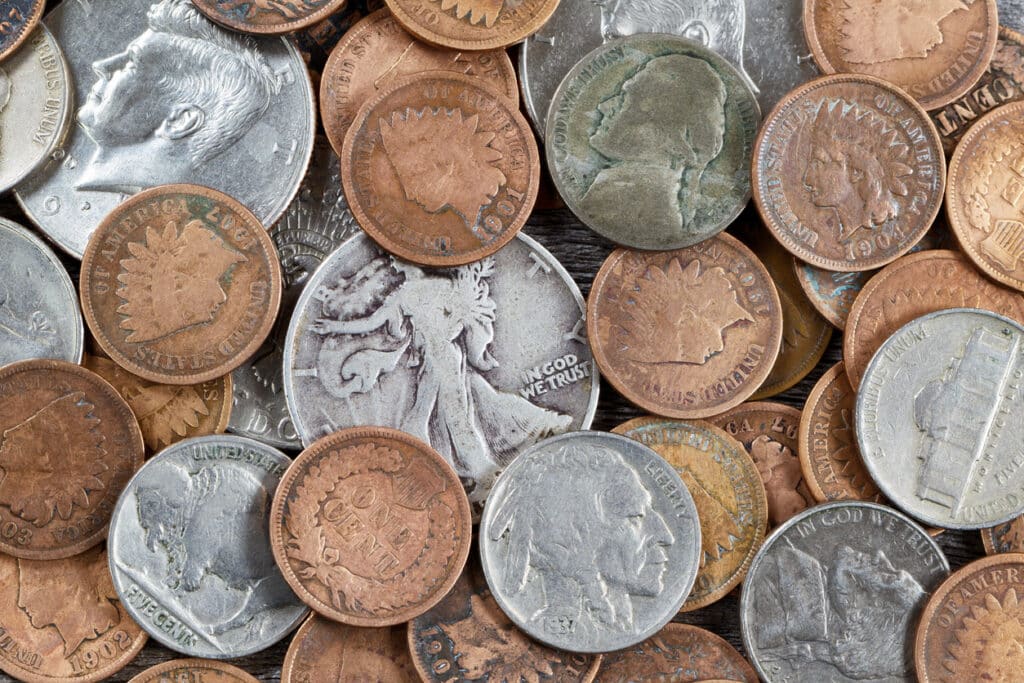The pricing of old coins can be a complex and nuanced task. There are many factors involved, and for the most in-demand coins, some depend very much on human error and whim. To illustrate how these factors intersect, let’s take the 1943 copper cent as an example. This coin looks very much like the pennies you may have in your pocket or your spare change, but it’s worth much, much more. Let’s talk about why.
Old Coin Pricing: Error, Demand, and Whim
Everyone knows what copper pennies look like, but for one period during World War II, they looked slightly different. Copper was in short supply as the U.S. military demanded it all for the war effort. Because of this, the U.S. Mint decided to produce Lincoln cents made of zinc-coated steel in 1943. They became known as “steelies,” and they are popular with collectors.
However, mistakes were made, so the steelies were not the only 1943 cents produced. Some error coins were too. The 1943 copper cents are very valuable because they are:
Rare – A large handful of up to perhaps 40 cents were minted on bronze planchets meant for 1942 pennies. Today 27 1943 cents have been confirmed and graded.
In Demand – In 1958, a 16-year-old boy named Don Lutes, Jr. from Pittsfield, Massachusetts found a 1943 copper penny in his high school cafeteria change. His discovery sparked a frenzy of interest, as experts verified the rarity of the coin. Lutes’ penny eventually sold at auction for a whopping $40,000—a staggering sum at the time.
The 1943 copper cent became the stuff of coin-collecting lore. There are so many collectors of Lincoln wheat cents, and only a tiny number of these coins available, so demand for them is very high. Price follows demand. In 2019, this same rare coin was sold for an astonishing $204,000 at auction, solidifying its status as one of the most sought-after and valuable coins in American numismatic history.
Other Factors involved in Pricing Old Coins
In addition to scarcity and demand, a number of other factors also determine the pricing of old coins, including:
Condition – Coins that are in better condition, with less wear and damage, are generally more valuable. Coin grading is a standardized system used to assess a coin’s condition, ranging from poor to perfect uncirculated. Professional coin grading services, such as Numismatic Guaranty Corporation (NGC) and Professional Coin Grading Service (PCGS), provide standardized assessments of a coin’s condition. Coins graded by these services often command higher prices due to the confidence they provide in the coin’s quality.
Authenticity – Unfortunately, counterfeiting is a problem in the coin market today. Coins that come with a reputable certification of authenticity from a trusted grading authority tend to be more valuable.
Historical Significance – Coins preserve human history. Coins with historical significance or unique features, such as errors in minting or special designs, can have higher values. Historical context and the story behind a coin can greatly influence its desirability among collectors.
Material and Composition – The metal composition of a coin, such as silver or gold, also affects its value and can add intrinsic value to a coin based on the current market price of the precious metal it’s made of.
Mintage Year and Mint Mark – The year a coin was minted and the mint mark (indicating the minting location) can impact its value. Some years or mint marks might be rarer due to various factors, such as lower mintage or historical events.
Coin Type and Design – Different coin categories or types and designs have varying levels of appeal to collectors. Some series or themes are more popular than others, which can impact the pricing. This is a subset of demand and changes over time.
Market Conditions and Economy – The coin collecting market, like any other market, is subject to trends and fluctuations. Prices can be influenced by changes in collector preferences, economic conditions, and other external factors. Broader economic and political shifts can influence the pricing of collectibles, including old coins.
The story of the 1943 copper penny showcases the fascinating interplay between history, human error, scarcity, and collector enthusiasm in the pricing of old coins. It’s a reminder that unexpected treasures can always emerge.
If you’re new to coin collecting, it’s a good idea to do thorough research and possibly consult with experts before making any significant purchases or sales. If you have any questions about coin collecting or would like to acquire certain coins, please call us at Grand Rapids Coins. We are here to help coin enthusiasts find what they are looking for!

